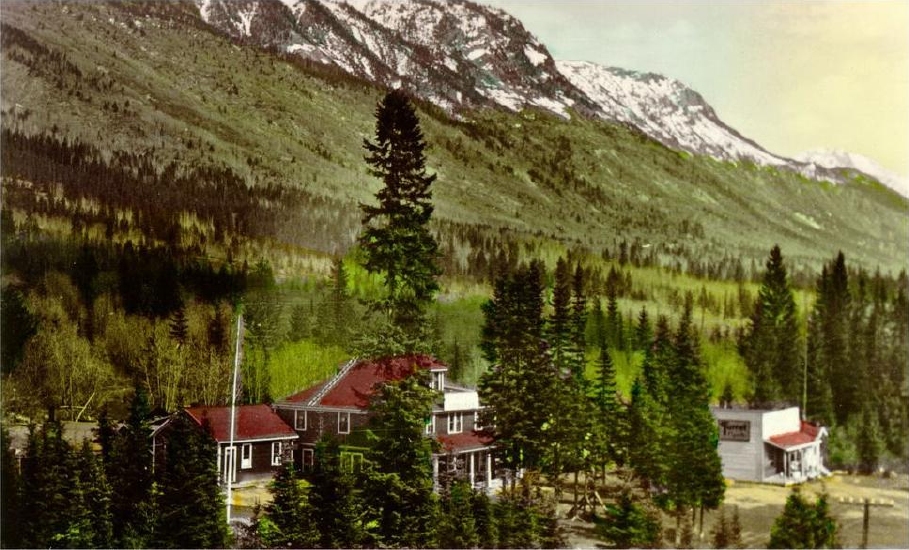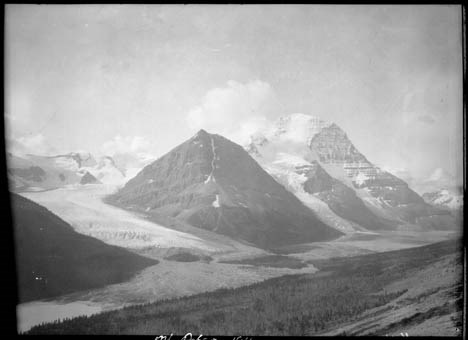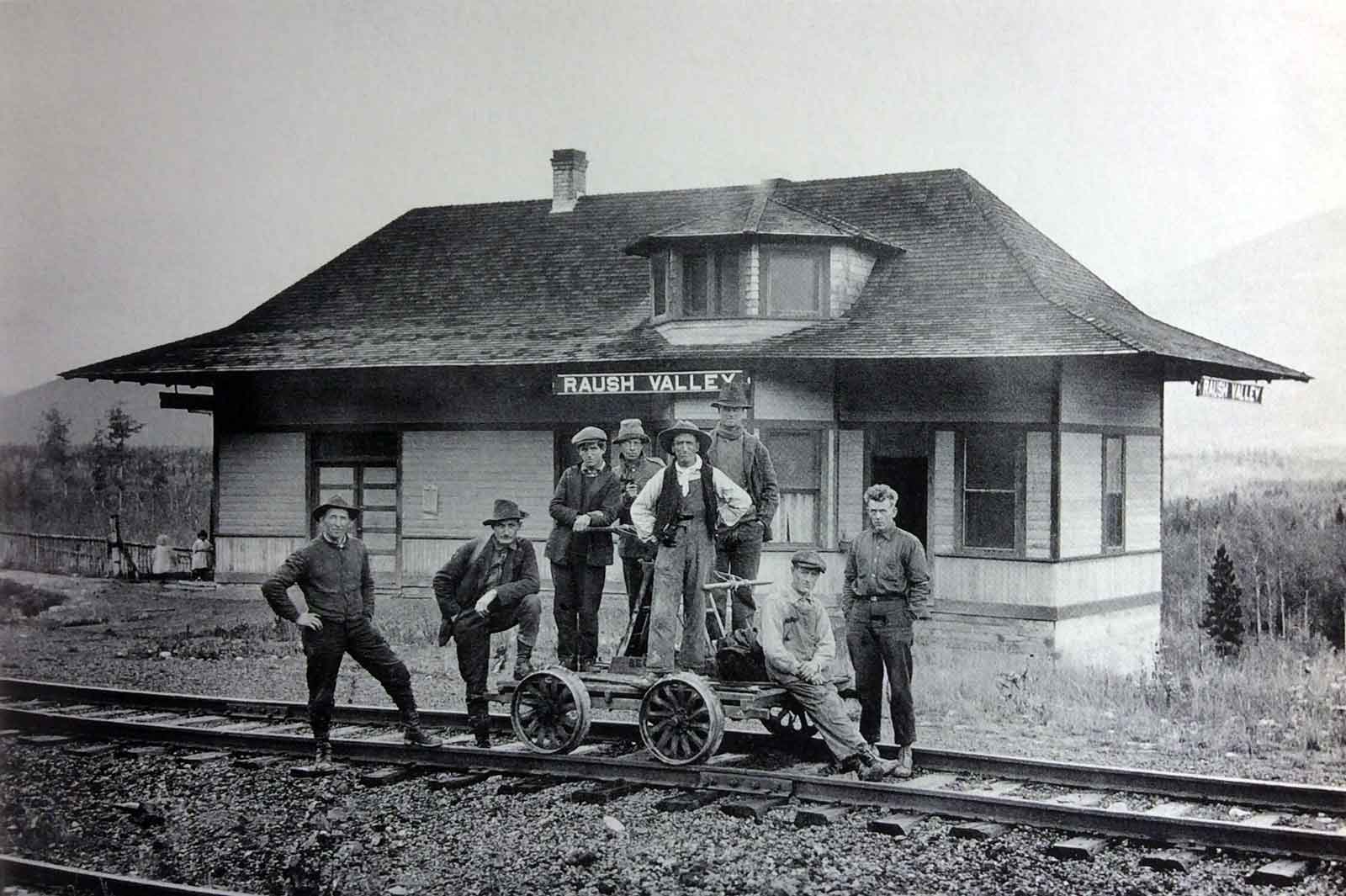Flows SW into Fraser near Penny
53.8353 N 121.2883 W — Map 093H14 — Google — GeoHack
Name officially adopted in 1958
Official in BC – Canada
Origin of the name unknown. There is no “Red Mountain” in the vicinity.

Topographical Map Showing Mount Robson and Mountains of the Continental Divide North of Yellowhead Pass. Detail of Moose Lake. 1912 Victoria Library, University of Toronto

Water tower and locomotive at Red Pass station. Canadian National steam engine 6057 (manufactured by Montreal Locomotive Works in 1930 and scrapped in 1960, 4-8-2, U-1-e). Valemount & Area Museum

Red Pass before 1949; colour tinted at a later date. Ishbel Cochrane. Valemount & Area Museum
The Red Pass railway point on Arthur Wheeler’s 1912 Topographical Map Showing Mount Robson and Mountains of the Continental Divide North of Yellowhead Pass is located near the middle of Moose Lake, not at the current location on the western end. The Grand Trunk Pacific Railway was the only railway through the pass at that time. The railway junction at Mile 27 at the west end of Moose Lake was originally called Resplendent, a name also deriving from the color of the rocks.
East of Red Pass junction, the tracks of the Grand Trunk Pacific Railway, descending to the Fraser River on route to Prince George in 1912, were kept as low as possible. The tracks of the Canadian Northern Railway, heading for Albreda, were kept high. After the consolidation of the railways in 1923 as the Canadian National Railway, Lucerne disappeared as a divisional point and Resplendent blossomed as the current Red Pass Junction, the point where the removal of the separate tracks stopped and where the two lines diverged. Red Pass probably had a GTP Type E station at one time.
During the 1930s there was a hobo jungle at Red Pass where the vagabonds waited for trains. About 50 people lived at Red Pass in the 1940s. During World War II it was the site of a Japanese internment camp. The Red Pass hotel burned down in 1949. After the highway opened in 1962, the need for Red Pass diminished. Canadian National Railway still uses some buildings at Red Pass. The headquarters of Mount Robson Park were moved from Red Pass to Valemount in 1987. The lower railway line has since been discontinued and the junction was moved near Charles north of Valemount.
The post office was open from 1921 to 1976, when it was closed and moved to Valemount.
Postmasters:
C. W. Palmer 1921-1923
Earl Francis Woodley 1923-1946
Lloyd Francis Williams 1946-1967
Robert Francis McLeod 1967-1969
Lionel D. Young 1969-1972
Mrs Diane Audrey Rogers 1972-1973
Mrs Winnifred Lynn Castle 1973-1974
Mrs Margaret Wentzel 1974-1976
Mrs M. A. Watt 1976
Mrs P. Murphy 1976
Wrigleys 1918 Directory lists Red Pass junction as a “flag-station on the G. T. P. Ry., 22 miles west of Lucerne. Lucerne is nearest post office.”
The Jasper Booster weekly newspaper published a story on August 12, 1981, entitled “Mayor of Red Pass Steps Down”:
Since the end of July, Red Pass has been without a mayor and it is doubtful that the position will be filled in the near future. In fact, the mayor’s residence and office will no longer be available to serve as town hall but will be purchased by the Province of B.C. and removed from Mt Robson provincial park. The mayor has moved to Cranbrook and so ends the last private residence on the shores of Moose Lake. William Hallam (aka the mayor of Red Pass Junction or Old Bill) was a familiar face to most railroaders. Other than the CN gangs he was the only person to wave to in Red Pass and he was often out with his dog Pard checking over the trains. Many residents of Jasper would recognize Bill from his monthly trips into town to buy pipe tobacco and “visit his girlfriends.” Anyone who has ever talked to Bill knows he’s been around and he has lots of stories to prove it.
Looking at this pass from the Moose River valley during the 1911 Alpine Club of Canada–Smithsonian Robson Expedition, surveyor Arthur Oliver Wheeler [1860–1945] wrote,
To Konrad’s disappointment the “Finger of Kain” now showed a broad slab of rock, but it must have been a very thin one. Beneath, to the south, lay deep valley which opened on the west branch valley above our camp. It supplies an easy pass to the Fraser Valley, to which it opens about two miles below the south end of Moose Lake. Seen from the Fraser Valley, the rock exposures at the crest show a brilliant red and, on this account, it is here called the “Red Pass. Examination from the Fraser side showed that the head of the valley below us contained some beautiful alplands and a that a pony trail would be possible of construction. It would be shorter from the railway than the Moose River route.
“Konrad” was guide Conrad Kain [1883–1934].
A previously official name.
A Japanese internment camp was built here during World War II, but it was not utilized.

Robson Glacier, Rearguard Mountain and Mount Robson. Smithsonian-Alpine Club of Canada Mount Robson expedition.Photo: Byron Harmon, 1911 Whyte Museum of the Canadian Rockies
Kinney had accompanied Arthur Philemon Coleman [1852–1939] and Coleman’s brother Lucius on the first mountaineering expedition to Mount Robson in 1907, when they approached from the Fraser River side and got little further than Kinney Lake. They returned in 1908, guided by Adolphus Moberly [1887– ?] and John Yates [1880– ?], who took them up the Moose River valley and approached Robson from the north. They became the first people to report on Berg Lake, Tumbling Glacier, Robson Glacier, Rearguard Mountain, The Helmet, and Extinguisher Tower, features Kinney named after their appearances.
By walking a hundred yards from our camp into the valley Mount Robson came into view during the rare intervals when the clouds drifted away, disclosing an imposing dome of white rising eight thousand feet above our valley, the lower part banded with courses of rock. Immediately behind our little grove a half-mile of glacier flowed, separating us from the cliffs of the Rearguard, one of the subordinate peaks, which reached a height of about nine thousand feet.
— Coleman [2]
From his vantage on Mumm Peak during the 1911 Alpine Club of Canada–Smithsonian Robson Expedition, Arthur Oliver Wheeler [1860–1945] described the rugged ridge running from the centre of Mount Robson’s north-east face. “The ridge ends in a semi-detached rock mass, aptly named by Coleman ‘Rearguard.’”
Coleman did not claim to have named Rearguard.
Paleontologist Charles Doolittle Walcott [1850–1927] explored in the Mount Robson area in 1912:
Directly above Blue Glacier a point of rock was named by Dr. Coleman “The Helmet,” and the great black mountain in the center, which he called the “Rearguard,” is now given the Indian name of Iyatunga (Black Rock) (note: name approved by the Geographical Board of Canada, December, 1912.) [3]
“Iyatunga” is no longer official. No one seems to have used it except Walcott.
The name does not appear to be associated with Rearguard Mountain, nor does it appear on early maps. Keddie mentions in the report on his archeological survey, 1971:
In the upper Fraser, Chinook salmon head upstream from July 1 to August 31 and return down-stream from mid April to early June. The migration goes as far as Rearguard Falls (east of Tête Jaune Cache) and spawning occurs in almost every stream flowing into the Fraser below this point.
There is a sign at these falls indicating that they mark the limit of the upward migration of chinook salmon on the Fraser River. Hence the name “Rearguard.”
But according to naturalist Art Carson of Valemount:
The falls are now believed by Canada Fisheries and Oceans Department to be an insurmountable barrier to perhaps 90 percent of the salmon which attempt it, however. Of the successful ones (perhaps 350 to 550 per year) a few have even been found spawning in the glacial waters of the Robson River. As far as is known, Overlander Falls several kilometers upstream from Rearguard marks the true upper limit of migration, with the uppermost spawning beds (only large enough for a few fish) being located just below Overlander Falls adjacent to Denny Hogan’s early railway construction camp.
Feature type: road
Province: British Columbia
Location: Loops N off Hwy 16, E of Dunster
Latitude: 53.1292 N
Longitude: 119.7594 W
Google Maps

A photo of the Read Family including; Clive, Bernie, Arthur, David, Walter and Ilsa, 1950.
Valley Museum & Archives Society
Clive F. (1933-1985) and Sarah Joyce Read moved to the Dunster area in 1950. Clive, born in Tuxford, Saskatchewan, was a farmer, logging contractor, and breeder of Belgian draft horses. He was a member of the Dunster Community Association and the Farmers’ Institute.
A descriptive name possibly bestowed by the Alberta-British Columbia Boundary Commission in 1922.
“Across the deep valley of Red Pass stood a ridge of rock, where the strata were very nearly vertical, and the snow-filled couloirs so peculiarly shaped as to give the intervening rock the appearance of razor-blades,” wrote Arthur Oliver Wheeler [1860–1945] after the 1911 Alpine Club of Canada–Smithsonian Robson Expedition. “The culminating crest of the ridge was on that account called ‘Razor Peak.’”

Raush Valley station on the Grand Trunk Pacific Railway, 1921
Adams Collection, Valley Museum & Archives, McBride #1999.16. (From Bohi, 1977, p. 23)
Bohi:
Many GTP depots along the sparsely settled line through northern BC were built primarily to house section crews with the understanding that once traffic warranted, these buildings would be converted into operational stations. The men posing on the classic handcar were likely the local section gang that resided in the depot. The lack of a train bulletin, an order board or a trackside platform is a good indication that this building was used as a section house rather than a depot. In such cases, the freight shed of Type E stations was often used as a bunkroom by the section laborers, while the balance of the building was occupied by the section foreman and his family (note the two children in the background, left). In the early 1950s many underused combination stations were converted into freight and passenger shelters: all but the freight shed being demolished or removed, while the remaining portion was re-configured. At least twenty-five Type E stations, mostly along the BC North Line, were transformed into such FPS. The Raush Valley depot, built in 1913, had an exterior treatment of roughcast stucco and wooden walers added in 1927. The walls and ceiling were insulated in 1941. This depot was sold and removed in 1963.